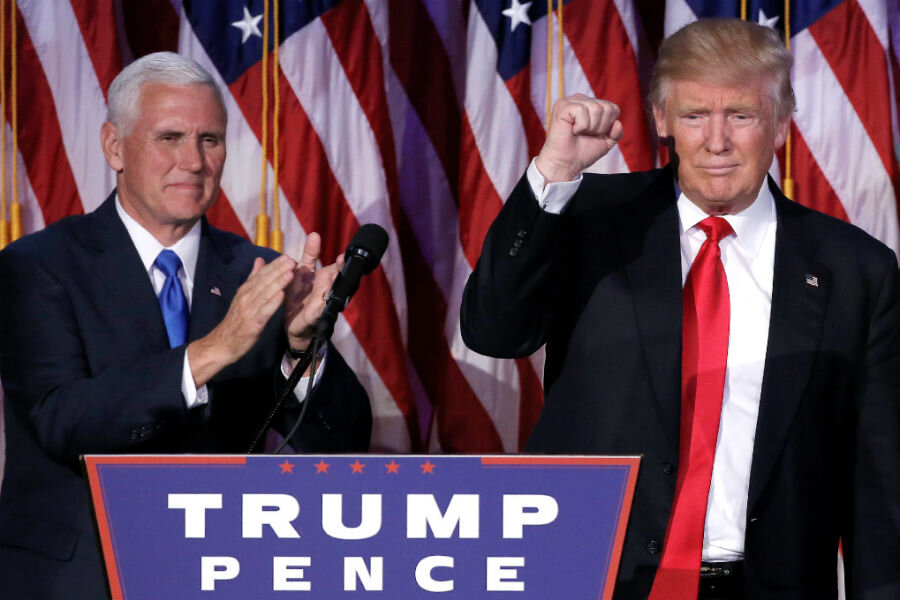Does Trump's 'Thank You' tour hold hints for his presidency?
Loading...
The Trump team’s "Thank You" tour began Thursday, and the series of rallies may provide an early indication of what Donald Trump’s presidency will look like, experts suggest.
President-elect Donald Trump and Vice President-elect Mike Pence scheduled events in Indiana and Ohio beginning on Thursday. The first event began Thursday afternoon, held at the Carrier manufacturing plant that has been the focus of a recent effort by the president-elect to keep manufacturing jobs in the United States. A rally is planned for Thursday evening at US Bank Arena in Cincinnati, where a huge crowd gathered to support Mr. Trump during the campaign.
Tweets and political rallies were a staple of the Trump campaign, allowing the candidate to communicate directly with voters. Political observers say Trump is likely to maintain these communication techniques when in office. But if Trump hopes to forge unity in a divided population, as he indicated during his victory speech, he may need to make some changes.
"The rhetoric he used deepened [existing] divides" by eliciting emotional responses, Patrick Miller, assistant professor of political science at the University of Kansas, tells The Christian Science Monitor in a phone interview.
Compared to previous presidents, Trump’s communication style is "radically different," Professor Miller explains. During the election campaign, he made extensive use of Twitter and political rallies to convey his message to Americans without going directly to the traditional media channels. And he repeatedly made headlines for his controversial statements about groups within American society, including Muslims and Latinos.
Because of this, it’s difficult to know how he will communicate as president. But the pattern of rallies and events is likely to hold, suggests Jacob Neiheisel, assistant professor of political science at State University System of New York (SUNY), Buffalo.
"Candidates (and campaigns) stick with what seems to have worked for them in the past," Professor Nieheisel writes in an email to the Monitor, adding, "He appears to have been very successful at firing up his base during the rallies, and I suspect that he will continue to rely upon such events to the extent that he is able."
And Trump’s team struggled to get him to present a more conventional "presidential" face to the world.
"Efforts to rein him in and change his style, that hasn’t succeeded … so maybe that means he’s going to continue with Twitter, the big rallies," says Miller, pointing to the Trump campaign’s failure to control the candidate’s Twitter feed and get him to use a teleprompter.
Trump advisers also say to expect more of these rallies, The Washington Post reported.
Though Trump’s rallies and tweets struck a chord with many Americans, critics expressed concern about the divisive rhetoric they seem to have encouraged. The president-elect denied that this rhetoric had gone too far.
"I won," he told The Wall Street Journal in his first post-election interview.
But Trump has also articulated a desire to bring the country together. In the same Wall Street Journal interview, he said, “I want a country that loves each other.” In his victory speech, he called for America to "bind the wounds of division."
Can Trump use the same communication techniques that stirred antagonism to heal divides in the country?
"If I get down to the nitty-gritty on a lot of issues, there’s more consensus between the average Democrat and the average Republican than you would think there would be," observes Miller, who studies partisanship and polling.
Certainly, there are intense disagreements on certain issues. Immigration emerged as one of these during the campaign. But more than anything, Miller says, it’s the symbolism of group labels, party-political or otherwise, that is really driving antagonism between Americans.
"The symbolism ... and the hatred and contempt that comes with that is so intense, more intense than it’s ever been," he explains. And Trump, he says, worked a lot of that divisive group rhetoric into his platform.
For Miller, the rallies are a medium through which ordinary Americans hear Donald Trump, whatever he’s saying – he may be able to maintain the same modes of communication yet bridge existing divides by shifting his rhetoric.
What Trump has been saying "may be how a lot of people feel ... but it’s not language that says, 'Hey, we’re all Americans regardless of our divisions,' " he concludes, suggesting that President Obama or Jeb Bush might serve as models for this kind of conciliatory speaking style.
Neiheisel at SUNY, though unconvinced that anything can transcend this "era of polarized parties and polarized voters," suggests that a change in medium could also help.
"Something like Roosevelt’s fireside chats would probably have the best chance," he writes.








